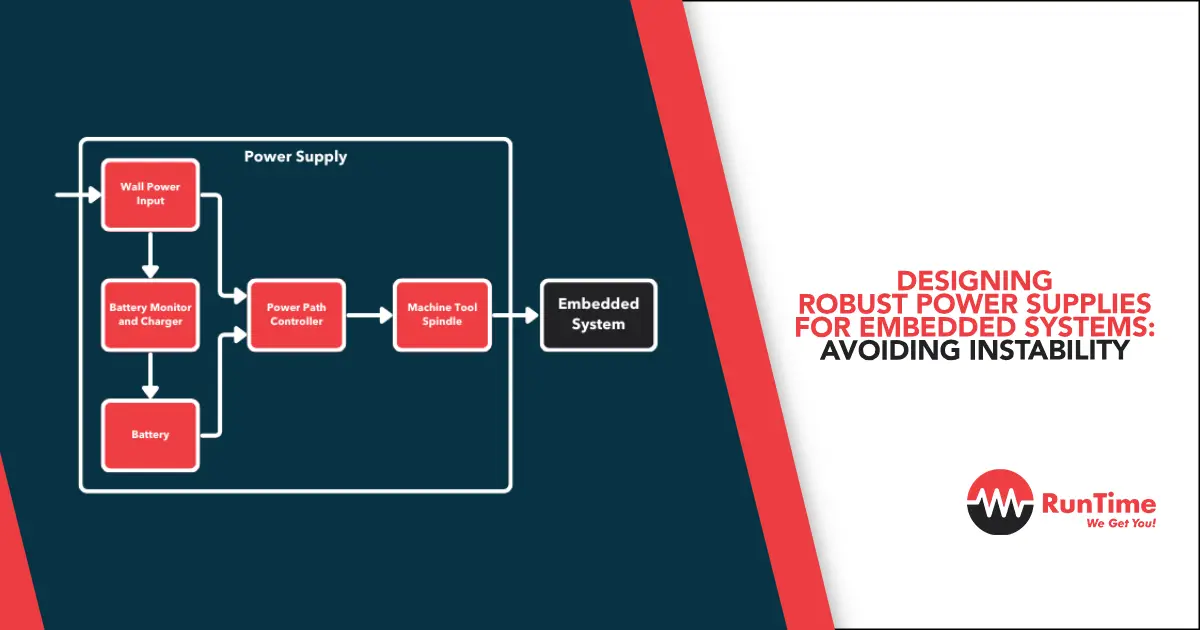Introduction
Embedded systems are at the heart of modern technology, powering everything from consumer electronics to industrial automation. A critical component of any embedded system is its power supply, which must deliver stable and reliable power to ensure proper operation. However, designing a robust power supply for embedded systems is not a trivial task. Power supply instability can lead to a host of issues, including system crashes, data corruption, and even hardware damage.
In this article, we will explore the challenges of designing robust power supplies for embedded systems, with a focus on avoiding instability. We will discuss the key factors that contribute to power supply instability, the techniques for designing stable power supplies, and the tools and methodologies that can help ensure a reliable power delivery system.
Understanding Power Supply Instability
What is Power Supply Instability?
Power supply instability refers to the inability of a power supply to maintain a stable output voltage under varying load conditions. This can manifest as voltage fluctuations, noise, or oscillations, which can disrupt the operation of the embedded system.
Why is Power Supply Stability Important?
Stable power is essential for the reliable operation of embedded systems. Microcontrollers, sensors, and other components require a stable voltage to function correctly. Instability in the power supply can lead to:
- System Crashes: Voltage fluctuations can cause microcontrollers to reset or behave unpredictably.
- Data Corruption: Noise on the power supply can corrupt data being processed or transmitted by the system.
- Hardware Damage: Excessive voltage spikes or drops can damage sensitive components.
- Reduced Performance: Power supply noise can interfere with signal integrity, reducing the performance of high-speed interfaces.
Factors Contributing to Power Supply Instability
Several factors can contribute to power supply instability, including:
- Load Variations: Embedded systems often have dynamic power requirements, with load currents varying significantly depending on the operational state.
- Component Tolerances: Variations in component values, such as capacitors and inductors, can affect the stability of the power supply.
- PCB Layout: Poor PCB layout can introduce noise and parasitic elements that destabilize the power supply.
- Feedback Loop Design: The design of the feedback loop in switching regulators is critical to maintaining stability.
- Environmental Factors: Temperature changes and electromagnetic interference (EMI) can impact power supply stability.
Best Practices for Designing Robust Power Supplies
1. Understanding Load Requirements
The first step in designing a robust power supply is to thoroughly understand the load requirements of the embedded system. This includes:
- Voltage Levels: Determine the required voltage levels for different components in the system.
- Current Consumption: Measure or estimate the current consumption of the system under different operational states.
- Transient Response: Analyze the system’s response to load transients, such as sudden increases or decreases in current demand.
Techniques for Load Analysis:
- Current Profiling: Use a current probe and oscilloscope to profile the current consumption of the system during different operational states.
- Load Step Testing: Perform load step tests to observe the power supply’s response to sudden changes in load current.
2. Selecting the Right Power Supply Topology
The choice of power supply topology is critical to achieving stability. Common power supply topologies for embedded systems include:
A. Linear Regulators
Linear regulators are simple and provide low-noise output, but they are inefficient for high current loads or large voltage differences between input and output.
plaintext
+——————-+
| |
| Linear Regulator |
| |
+———+———+
|
V
Output Voltage
B. Switching Regulators
Switching regulators, such as buck, boost, and buck-boost converters, are more efficient but require careful design to ensure stability.
plaintext
+——————-+
| |
| Switching Regulator |
| |
+———+———+
|
V
Output Voltage
C. Low-Dropout (LDO) Regulators
LDO regulators are a type of linear regulator that can operate with a small voltage difference between input and output, making them suitable for low-power applications.
plaintext
+——————-+
| |
| LDO Regulator |
| |
+———+———+
|
V
Output Voltage
3. Designing the Feedback Loop
The feedback loop is a critical component of switching regulators, as it controls the output voltage by adjusting the duty cycle of the switching transistor. Proper design of the feedback loop is essential to avoid instability.
A. Compensation Network
The compensation network in the feedback loop is used to stabilize the regulator by shaping the loop gain and phase response. Common compensation techniques include:
- Type II Compensation: Uses a combination of resistors and capacitors to provide a pole and a zero in the loop response.
- Type III Compensation: Adds an additional pole and zero to provide better stability for higher bandwidth designs.
plaintext
+——————-+
| |
| Compensation |
| Network |
| |
+———+———+
|
V
Feedback Signal
B. Loop Gain and Phase Margin
The loop gain and phase margin are key parameters that determine the stability of the feedback loop. The phase margin should be greater than 45 degrees to ensure stability.
plaintext
+——————-+
| |
| Loop Gain |
| and Phase Margin |
| |
+———+———+
|
V
Stability Analysis
4. PCB Layout Considerations
Proper PCB layout is essential to minimize noise and parasitic elements that can destabilize the power supply. Key considerations include:
A. Component Placement
- Minimize Loop Areas: Place components to minimize the loop area of high-current paths, reducing inductance and EMI.
- Decoupling Capacitors: Place decoupling capacitors close to the power pins of ICs to provide local energy storage and reduce noise.
B. Routing
- Short and Wide Traces: Use short and wide traces for high-current paths to reduce resistance and inductance.
- Ground Plane: Use a solid ground plane to provide a low-impedance return path for currents.
C. Thermal Management
- Heat Dissipation: Ensure adequate heat dissipation for power components, such as switching transistors and inductors, to prevent thermal instability.
5. Testing and Validation
Testing and validation are critical to ensuring the stability and reliability of the power supply. This includes both simulation and hardware testing.
A. Simulation
Simulation tools, such as SPICE, can be used to model the power supply and analyze its stability under different load conditions. Key simulations include:
- Transient Response: Analyze the response of the power supply to load transients.
- AC Analysis: Perform AC analysis to evaluate the loop gain and phase margin.
B. Hardware Testing
Hardware testing involves measuring the performance of the power supply in the actual system. Key tests include:
- Load Step Testing: Measure the response of the power supply to sudden changes in load current.
- Noise and Ripple Measurement: Use an oscilloscope to measure the noise and ripple on the output voltage.
- Thermal Testing: Monitor the temperature of power components to ensure they operate within safe limits.
6. Using Power Management ICs
Power management ICs (PMICs) integrate multiple power supply functions into a single chip, simplifying the design and improving stability. PMICs often include features such as:
- Integrated Switching Regulators: Provide efficient power conversion with built-in compensation networks.
- LDO Regulators: Offer low-noise output for sensitive components.
- Power Sequencing: Ensure proper power-up and power-down sequences for multi-voltage systems.
plaintext
+——————-+
| |
| Power Management |
| IC (PMIC) |
| |
+———+———+
|
V
Multiple Outputs
7. Environmental Considerations
Environmental factors, such as temperature and EMI, can impact the stability of the power supply. Key considerations include:
A. Temperature Compensation
- Thermal Derating: Ensure that components are rated for the expected temperature range.
- Thermal Management: Use heat sinks, thermal vias, and adequate ventilation to manage heat dissipation.
B. EMI Mitigation
- Shielding: Use shielding to protect sensitive components from EMI.
- Filtering: Implement filtering on input and output lines to reduce conducted EMI.
Conclusion
Designing robust power supplies for embedded systems is a complex but essential task. By understanding the factors that contribute to power supply instability and following the best practices outlined in this article, embedded engineers can ensure that their power supplies deliver stable and reliable power to their systems. Proper load analysis, selection of the right power supply topology, careful design of the feedback loop, and thorough testing and validation are key to achieving power supply stability.
As embedded systems continue to evolve, the importance of robust power supply design will only increase. By adopting these best practices, embedded engineers can confidently tackle the challenges of power supply design and deliver high-quality, reliable embedded systems.









